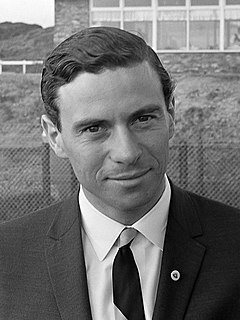Brabham is the common name for Motor Racing Developments Ltd., a British racing car manufacturer and Formula One racing team. Founded in 1960 by Australian driver Jack Brabham and British-Australian designer Ron Tauranac, the team won four Drivers' and two Constructors' World Championships in its 30-year Formula One history. Jack Brabham's 1966 FIA Drivers' Championship remains the only such achievement using a car bearing the driver's own name.

The 1959 Portuguese Grand Prix was a Formula One motor race held at Monsanto on 23 August 1959. It was race 7 of 9 in the 1959 World Championship of Drivers and race 6 of 8 in the 1959 International Cup for Formula One Manufacturers. It was the eighth Portuguese Grand Prix and the second to be held for the Formula One World Drivers' Championship. It was the third time the race was held at Monsanto and the first for Formula One. The race was held over 62 laps of the five kilometre circuit for a total race distance of 337 kilometres.

The 1959 Italian Grand Prix was a Formula One motor race held at Monza on 13 September 1959. It was race 8 of 9 in the 1959 World Championship of Drivers and race 7 of 8 in the 1959 International Cup for Formula One Manufacturers. It was the 29th Italian Grand Prix and the 24th to be held at Monza. The race was held over 72 laps of the five kilometre circuit for a total race distance of 414 kilometres.

The 1966 Italian Grand Prix was a Formula One motor race held at Monza on 4 September 1966. It was race 7 of 9 in both the 1966 World Championship of Drivers and the 1966 International Cup for Formula One Manufacturers. The race was the 36th Italian Grand Prix and the 32nd to be held at Monza. The race was held over 68 laps of the five kilometre circuit for a race distance of 391 kilometres.

The 1966 Mexican Grand Prix was a Formula One motor race held at the Ciudad Deportiva Magdalena Mixhuca on 23 October 1966. It was race 9 of 9 in both the 1966 World Championship of Drivers and the 1966 International Cup for Formula One Manufacturers. The race was the fifth Mexican Grand Prix and the first to be run under the new three-litre Formula. It was held over 65 laps of the 5 km (3.1 mi) circuit for a race distance of 325 km (202 mi).

The 1969 Gran Premio de Mexico was a Formula One motor race held at the Ciudad Deportiva Magdalena Mixhuca, Mexico City on October 19, 1969, two weeks after the United States Grand Prix at Watkins Glen. It was race 11 of 11 in both the 1969 World Championship of Drivers and the 1969 International Cup for Formula One Manufacturers. The 65-lap race was won by McLaren driver Denny Hulme after he started from fourth position. Jacky Ickx finished second for the Brabham team and his teammate Jack Brabham came in third.

The 1975 British Grand Prix was a Formula One motor race held at Silverstone on 19 July 1975. It was race 10 of 14 in both the 1975 World Championship of Drivers and the 1975 International Cup for Formula One Manufacturers. It was the 30th British Grand Prix to be held since the race was first held in 1926 and the 17th time the race had been held at Silverstone. The race was held over 56 of the scheduled 67 laps of the four kilometre venue for a race distance of 264 kilometres.

The 1967 Formula One season was the 21st season of FIA Formula One motor racing. It featured the 1967 World Championship of Drivers and the 1967 International Cup for F1 Manufacturers, contested concurrently over an eleven race series which commenced on 2 January, and ended on 22 October. The season also included a number of non-championship races for Formula One cars. Denny Hulme won the World Championship of Drivers and Brabham-Repco was awarded the International Cup for F1 Manufacturers.

The 1966 Formula One season was the 20th season of FIA Formula One motor racing. It featured the 1966 World Championship of Drivers and the 1966 International Cup for F1 Manufacturers which were contested concurrently over a nine-race series that commenced on 22 May and ended on 23 October. The season also included a number of non-championship races for Formula One cars.

The 1965 Formula One season, which was the 19th season of FIA Formula One racing, featured the 16th World Championship of Drivers and the 8th International Cup for F1 Manufacturers. The two titles were contested concurrently over a ten-round series which commenced on 1 January and ended on 24 October. The season also included a number of non championship races for Formula One cars.

The 1963 Formula One season was the 17th season of FIA Formula One motor racing. It featured the 14th FIA World Championship of Drivers, the sixth International Cup for F1 Manufacturers and numerous non-championship Formula One races. The World Championship commenced on 26 May, and ended on 28 December after ten races.

The 1962 Formula One season was the 16th season of FIA Formula One motor racing. It featured the 1962 World Championship of Drivers and the 1962 International Cup for F1 Manufacturers which were contested concurrently over a nine race series that commenced on 20 May and ended on 29 December. The season also included a number of non-championship races for Formula One cars.

The 1959 Formula One season was the 13th season of FIA Formula One motor racing. It featured the 1959 World Championship of Drivers and the 1959 International Cup for F1 Manufacturers, contested concurrently over a nine-race series which commenced on 10 May and ended on 12 December. The season also included a number of non-championship Formula One races.

Repco is an Australian automotive engineering/retailer company. Its name is an abbreviation of Replacement Parts Company and it is best known for spare parts and motor accessories.

The Brabham BT19 is a Formula One racing car designed by Ron Tauranac for the British Brabham team. The BT19 competed in the 1966 and 1967 Formula One World Championships and was used by Australian driver Jack Brabham to win his third World Championship in 1966. The BT19, which Brabham referred to as his "Old Nail", was the first car bearing its driver's name to win a World Championship race.

The Repco Brabham BT24 was a Formula One racing car design. It was one of three cars used by the Brabham racing team during their championship-winning 1967 Formula One season. Only three BT24 chassis were ever raced.

The Brabham BT3 is a Formula One racing car. It was the first Formula One design to be produced by Motor Racing Developments for the Brabham Racing Organisation, and debuted at the 1962 German Grand Prix. The Brabham BT3 was the vehicle with which team owner – then two-time World Champion – Jack Brabham, became the first driver ever to score World Championship points in a car bearing his own name, at the 1962 United States Grand Prix. The following year Brabham also became the first driver ever to win a Formula One race at the wheel of an eponymous car, again driving the BT3, at the 1963 Solitude Grand Prix. The BT3 design was modified only slightly to form the Tasman Series-specification Brabham BT4 cars.

The Brabham BT20 is a Formula One car used by the Brabham Formula One team in 1966 and 1967, as well as a number of privateers from 1967 to 1969. The BT20 was the direct successor to the Brabham BT19 which was driven to the World Constructors' title in 1966.

The Brabham BT11 is a Formula One racing car built in 1964, mainly for use by privateers in grand prix racing, but was also used by the Brabham works team during 1964 and 1965. It was the only competitive car of the period available to privateers, recording eight podium finishes in total. The car's best results came at consecutive events in the United States and Mexico 1965, with Dan Gurney qualifying and finishing second in the latter.

The Brabham BT43 was the only Formula 5000 racing car built by Motor Racing Developments (MRD). Initiated by Ron Tauranac, designed by Geoff Ferris, and built by a team including Nick Goozee (monocoque) and Bob Paton (construction), it was one of the last cars produced by MRD before MRD was closed by the then new Brabham owner Bernie Ecclestone. Based on the Formula Two Brabham BT40 the BT43 featured a modified monocoque that incorporated the triangular cross section pioneered by the Brabham BT42 Formula One car which was designed by Gordon Murray. This distinctive pyramid shape not only kept the aerodynamic "stagnation point" low but also neatly allowed the incorporation of a "crushable structure" as required by the 1973 regulations which specified that all fuel tanks were to be protected by deformable structures. Engine and gearbox were the then de facto F5000 standard combination of a Chevrolet 302 cubic inch engine in an unstressed mounting and a Hewland DG300 gearbox. The fitment of these into what was a relatively small Formula Two sized car presented some design challenges. Front suspension components were BT40 while rear suspension components were a combination of Formula One and BT40.















